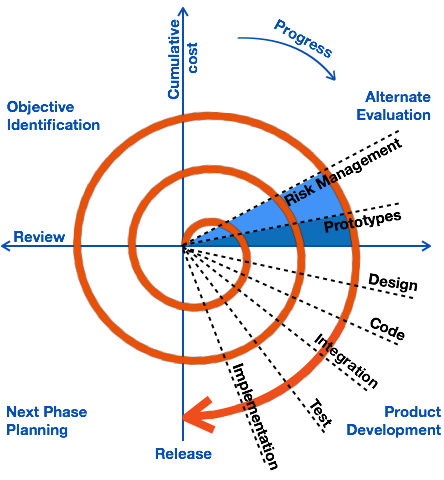
- SDLC Tutorial
- SDLC - Home
- SDLC - Overview
- SDLC - Waterfall Model
- SDLC - Iterative Model
- SDLC - Spiral Model
- SDLC - V-Model
- SDLC - Big Bang Model
- SDLC - Agile Model
- SDLC - RAD Model
- SDLC - Software Prototype
- SDLC Useful Resources
- SDLC - Quick Guide
- SDLC - Useful Resources
- SDLC - Discussion
SDLC - Spiral Model
The spiral model combines the idea of iterative development with the systematic, controlled aspects of the waterfall model. This Spiral model is a combination of iterative development process model and sequential linear development model i.e. the waterfall model with a very high emphasis on risk analysis. It allows incremental releases of the product or incremental refinement through each iteration around the spiral.
Spiral Model - Design
The spiral model has four phases. A software project repeatedly passes through these phases in iterations called Spirals.
Identification
This phase starts with gathering the business requirements in the baseline spiral. In the subsequent spirals as the product matures, identification of system requirements, subsystem requirements and unit requirements are all done in this phase.
This phase also includes understanding the system requirements by continuous communication between the customer and the system analyst. At the end of the spiral, the product is deployed in the identified market.
Design
The Design phase starts with the conceptual design in the baseline spiral and involves architectural design, logical design of modules, physical product design and the final design in the subsequent spirals.
Construct or Build
The Construct phase refers to production of the actual software product at every spiral. In the baseline spiral, when the product is just thought of and the design is being developed a POC (Proof of Concept) is developed in this phase to get customer feedback.
Then in the subsequent spirals with higher clarity on requirements and design details a working model of the software called build is produced with a version number. These builds are sent to the customer for feedback.
Evaluation and Risk Analysis
Risk Analysis includes identifying, estimating and monitoring the technical feasibility and management risks, such as schedule slippage and cost overrun. After testing the build, at the end of first iteration, the customer evaluates the software and provides feedback.
The following illustration is a representation of the Spiral Model, listing the activities in each phase.

Based on the customer evaluation, the software development process enters the next iteration and subsequently follows the linear approach to implement the feedback suggested by the customer. The process of iterations along the spiral continues throughout the life of the software.
Spiral Model Application
The Spiral Model is widely used in the software industry as it is in sync with the natural development process of any product, i.e. learning with maturity which involves minimum risk for the customer as well as the development firms.
The following pointers explain the typical uses of a Spiral Model −
When there is a budget constraint and risk evaluation is important.
For medium to high-risk projects.
Long-term project commitment because of potential changes to economic priorities as the requirements change with time.
Customer is not sure of their requirements which is usually the case.
Requirements are complex and need evaluation to get clarity.
New product line which should be released in phases to get enough customer feedback.
Significant changes are expected in the product during the development cycle.
Spiral Model - Pros and Cons
The advantage of spiral lifecycle model is that it allows elements of the product to be added in, when they become available or known. This assures that there is no conflict with previous requirements and design.
This method is consistent with approaches that have multiple software builds and releases which allows making an orderly transition to a maintenance activity. Another positive aspect of this method is that the spiral model forces an early user involvement in the system development effort.
On the other side, it takes a very strict management to complete such products and there is a risk of running the spiral in an indefinite loop. So, the discipline of change and the extent of taking change requests is very important to develop and deploy the product successfully.
The advantages of the Spiral SDLC Model are as follows −
Changing requirements can be accommodated.
Allows extensive use of prototypes.
Requirements can be captured more accurately.
Users see the system early.
Development can be divided into smaller parts and the risky parts can be developed earlier which helps in better risk management.
The disadvantages of the Spiral SDLC Model are as follows −
Management is more complex.
End of the project may not be known early.
Not suitable for small or low risk projects and could be expensive for small projects.
Process is complex
Spiral may go on indefinitely.
Large number of intermediate stages requires excessive documentation.